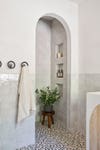An Elevated Take on a Rustic Bathroom Calls for Multicolored Marble Floor Tile
It’s a jewel-tone paradise for your feet.
Updated Oct 12, 2018 2:19 AM
We may earn revenue from the products available on this page and participate in affiliate programs.
Erica Johnston didn’t just have her two clients to consider when redesigning the dungeon-like main bathroom in their Portola Valley, California, home. The homeowners’ two large dogs also frequent the spot. “Their Newfoundland is like a furry black bear, and it turns out he loves to sleep in the shower,” says the designer with a laugh. A floor refresh was a must, but the material didn’t just have to be cooling (for aforementioned doggie naps), it had to look good, too. Enter: multicolored marble tile. The Artistic Tile find comes in affordable 12-by-12 sheets, and the scale of the pattern is so small it didn’t overwhelm the space. “It’s like a jewel-tone marble paradise,” says Johnston.
Not up for a DIY? Never fear: Kick-start your project with HomeAdvisor’s directory of ceramic tile installers in your area.
While the home isn’t technically a farmhouse, the couple was after that earthy-rustic look. Johnston’s job was to inject the room with a little bit of whimsy and a little bit of country, while still making it fit with the rest of the place’s modern architecture. Step one: “I didn’t go bright white,” she explains. Textured walls galore and a touch of bleached oak fulfilled everyone’s needs—pups included.
Lean Into Plaster


Like the old-world Moroccan wall treatment tadelakt (the coating on the new vanity), the raw untinted plaster Johnston used on the walls is water-resistant, since it’s sealed with a wax finish. “It plays with the quality of light coming in through the window nicely,” she points out.
Around the room, the designer added a wainscoting-like treatment made up of square zellige tiles. This way no little fingerprints (the couple has three children) or marks from wagging tails show up on the plaster. Johnston doubled up on the drywall so that the whole surface, ceiling to floor, was flush. “Therefore you don’t have a ledge that collects dust, and we’re bringing together these two really natural and man-made elements,” she explains.
Know Your Sealer
Not changing the layout of the room was a huge budget save (it meant not paying to move the plumbing). Instead, Johnston simply replaced the vanity with a custom version that features white oak doors that went through several stages of bleaching to achieve the perfect worn look. “You always have to ask what type of sealer your contractor is using, because a lot of times an oil-based stain will give oak an amber yellow appearance,” she warns. The best move is a water-based stain—and of course requesting to see samples.


The designer was able to bring in extra storage by adding two deep cabinets on both ends. The drawers have hidden outlets inside, so common eyesores like a hair dryer can be tucked away neatly. “We were able to splurge on the solid white oak drawers and doors because the rest of the vanity was crafted from plywood,” she says.
Pare Down the Reclaimed Wood
Cladding the immovable ceiling beam in wood was an easy way to bring a touch of farmhouse into the space. Johnston turned to The Hudson Company to source reclaimed mushroom board for the structural feature. “It isn’t like hand-hewn beams that have big chunks cut out,” she notes. “It has a clean and pretty raised grain.” Shiplap can’t compare.



